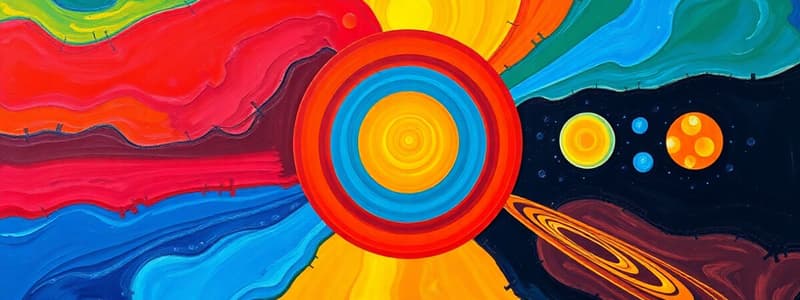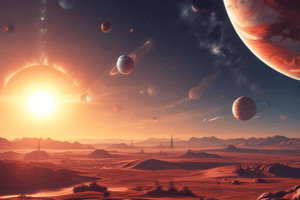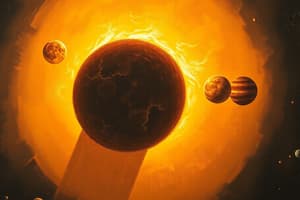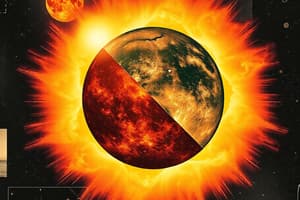Podcast
Questions and Answers
What is the primary process by which carbon enters the biotic environment?
What is the primary process by which carbon enters the biotic environment?
- Respiration
- Combustion
- Decomposition
- Photosynthesis (correct)
Most of Earth's carbon is actively cycled through the environment.
Most of Earth's carbon is actively cycled through the environment.
False (B)
What are the three main ways atmospheric nitrogen (N2) can be converted into nitrates?
What are the three main ways atmospheric nitrogen (N2) can be converted into nitrates?
Lightning, UV radiation, and nitrogen fixation by nitrogen-fixing bacteria.
The burning of fossil fuels is a major contributor to the release of ______ into the atmosphere.
The burning of fossil fuels is a major contributor to the release of ______ into the atmosphere.
Match the following terms with their respective processes:
Match the following terms with their respective processes:
Which of the following is NOT a consequence of increased nitrogen levels in aquatic ecosystems?
Which of the following is NOT a consequence of increased nitrogen levels in aquatic ecosystems?
Ocean acidification is a direct consequence of increased carbon dioxide absorption by oceans.
Ocean acidification is a direct consequence of increased carbon dioxide absorption by oceans.
What are the two primary anthropogenic sources of carbon dioxide emissions?
What are the two primary anthropogenic sources of carbon dioxide emissions?
The process by which organisms convert glucose and oxygen into carbon dioxide and water is known as ______.
The process by which organisms convert glucose and oxygen into carbon dioxide and water is known as ______.
What is the primary role of nitrogen-fixing bacteria in the nitrogen cycle?
What is the primary role of nitrogen-fixing bacteria in the nitrogen cycle?
Which of these planets are considered gas giants?
Which of these planets are considered gas giants?
The Big Bang Theory states that the universe began with a giant explosion approximately 14 billion years ago.
The Big Bang Theory states that the universe began with a giant explosion approximately 14 billion years ago.
What is the name of the outermost layer of the Sun's atmosphere?
What is the name of the outermost layer of the Sun's atmosphere?
Artificial satellites are used to forecast the ______, aid in navigation (GPS), and explore the universe.
Artificial satellites are used to forecast the ______, aid in navigation (GPS), and explore the universe.
Match the following parts of the Sun with their descriptions:
Match the following parts of the Sun with their descriptions:
Which of the following is NOT a sphere of the Earth?
Which of the following is NOT a sphere of the Earth?
What is the equation for photosynthesis?
What is the equation for photosynthesis?
Sustainability refers to meeting the needs of the present generation without compromising the ability of future generations to meet their own needs.
Sustainability refers to meeting the needs of the present generation without compromising the ability of future generations to meet their own needs.
What is primary succession?
What is primary succession?
Secondary succession occurs when a disturbance completely destroys an ecosystem.
Secondary succession occurs when a disturbance completely destroys an ecosystem.
Name one impact of climate change on agriculture.
Name one impact of climate change on agriculture.
The atomic number of an element represents the number of __________ in its nucleus.
The atomic number of an element represents the number of __________ in its nucleus.
Match the following groups with their properties:
Match the following groups with their properties:
What happens to the biodiversity when habitats become unsuitable due to climate change?
What happens to the biodiversity when habitats become unsuitable due to climate change?
What is an ion?
What is an ion?
To find the number of neutrons in an atom, use the formula N = A - __________.
To find the number of neutrons in an atom, use the formula N = A - __________.
Which group of elements is characterized as being gases at room temperature and highly stable?
Which group of elements is characterized as being gases at room temperature and highly stable?
Cations are formed when an atom gains electrons.
Cations are formed when an atom gains electrons.
What is the charge of a sodium ion (Na)?
What is the charge of a sodium ion (Na)?
When chlorine gains an electron, it becomes a __________ ion.
When chlorine gains an electron, it becomes a __________ ion.
Which of the following regions is at high risk of flooding due to rising sea levels?
Which of the following regions is at high risk of flooding due to rising sea levels?
Match the scientist with their discovery related to atomic structure:
Match the scientist with their discovery related to atomic structure:
What is the primary characteristic of ionic compounds?
What is the primary characteristic of ionic compounds?
All atoms of different elements are identical.
All atoms of different elements are identical.
What happens during decomposition of a substance?
What happens during decomposition of a substance?
The charging process that occurs when two objects rub together is called ______.
The charging process that occurs when two objects rub together is called ______.
Match the scientist with their corresponding discovery:
Match the scientist with their corresponding discovery:
Which of the following is a characteristic of metals in ionic compounds?
Which of the following is a characteristic of metals in ionic compounds?
Electrons can be located between orbits in the Bohr model.
Electrons can be located between orbits in the Bohr model.
What is grounding?
What is grounding?
An object becomes negatively charged when it ______ electrons.
An object becomes negatively charged when it ______ electrons.
Match the electrical concepts with their definitions:
Match the electrical concepts with their definitions:
Which option describes a characteristic of a non-renewable energy resource?
Which option describes a characteristic of a non-renewable energy resource?
Ionic compounds are electrically neutral overall.
Ionic compounds are electrically neutral overall.
What does Ohm's Law state about current, voltage, and resistance?
What does Ohm's Law state about current, voltage, and resistance?
When electrons are transferred between objects through contact, the process is called ______.
When electrons are transferred between objects through contact, the process is called ______.
In an ionic compound's name, what changes for the non-metal ion?
In an ionic compound's name, what changes for the non-metal ion?
What occurs during charging by friction?
What occurs during charging by friction?
Electrons are lost as a whole during charging processes.
Electrons are lost as a whole during charging processes.
What is the primary difference between charging by contact and charging by induction?
What is the primary difference between charging by contact and charging by induction?
The unit of measure for resistance is __________.
The unit of measure for resistance is __________.
Match the type of current with its description:
Match the type of current with its description:
Which of the following describes the flow of current in a DC circuit?
Which of the following describes the flow of current in a DC circuit?
Electrical conductors allow easy movement of electrons.
Electrical conductors allow easy movement of electrons.
What is the role of a voltmeter in a circuit?
What is the role of a voltmeter in a circuit?
The formula for resistance is __________.
The formula for resistance is __________.
What happens to the charge of a neutral object that comes into contact with a positively charged object?
What happens to the charge of a neutral object that comes into contact with a positively charged object?
A fair conductor allows only some movement of electrons.
A fair conductor allows only some movement of electrons.
What is Ohm's Law?
What is Ohm's Law?
Current is measured in __________ and is represented by the symbol __________.
Current is measured in __________ and is represented by the symbol __________.
Match the following electrical components with their functions:
Match the following electrical components with their functions:
What is a significant negative impact of human activity on ecosystems?
What is a significant negative impact of human activity on ecosystems?
Biodiversity has no impact on ecosystem stability.
Biodiversity has no impact on ecosystem stability.
Explain how dead organic matter contributes to the cycling of nitrogen.
Explain how dead organic matter contributes to the cycling of nitrogen.
The process of _______ leads to an increase in nutrients in aquatic environments, often resulting in excessive algae growth.
The process of _______ leads to an increase in nutrients in aquatic environments, often resulting in excessive algae growth.
Which of the following statements about agroecosystems is true?
Which of the following statements about agroecosystems is true?
Only producers participate in cellular respiration.
Only producers participate in cellular respiration.
What is the role of chlorophyll in photosynthesis?
What is the role of chlorophyll in photosynthesis?
Your carbon footprint measures the total amount of ________ emitted by your activities.
Your carbon footprint measures the total amount of ________ emitted by your activities.
Which process describes the transformation of vapor to liquid as part of the water cycle?
Which process describes the transformation of vapor to liquid as part of the water cycle?
Match the following processes with their effects:
Match the following processes with their effects:
Ecosystems with higher species richness have less resilience to environmental changes.
Ecosystems with higher species richness have less resilience to environmental changes.
What aspect of the human impact on the water cycle is associated with irrigation?
What aspect of the human impact on the water cycle is associated with irrigation?
The two main components of cellular respiration are ________ and ________.
The two main components of cellular respiration are ________ and ________.
What is the overall charge of a helium atom with 2 protons and 2 electrons?
What is the overall charge of a helium atom with 2 protons and 2 electrons?
Anions are formed when atoms lose electrons.
Anions are formed when atoms lose electrons.
What suffix is added to the name of an anion derived from a non-metal?
What suffix is added to the name of an anion derived from a non-metal?
A compound formed from the combination of metals and nonmetals is known as an __________ compound.
A compound formed from the combination of metals and nonmetals is known as an __________ compound.
Match the following types of compounds with their characteristics:
Match the following types of compounds with their characteristics:
Which of the following is a characteristic of density?
Which of the following is a characteristic of density?
What is a typical chemical property of a substance related to its ability to burn?
What is a typical chemical property of a substance related to its ability to burn?
For an element with 12 protons, its corresponding cation after losing two electrons would carry a charge of __________.
For an element with 12 protons, its corresponding cation after losing two electrons would carry a charge of __________.
What is the potential difference provided by the battery if 0.5A of current flows through a conductor with 18Ω of resistance?
What is the potential difference provided by the battery if 0.5A of current flows through a conductor with 18Ω of resistance?
In a series circuit, the voltage is the same across all components.
In a series circuit, the voltage is the same across all components.
How does the resistance change in a series circuit when more loads are added?
How does the resistance change in a series circuit when more loads are added?
In a parallel circuit, the voltage across each device is ______.
In a parallel circuit, the voltage across each device is ______.
Match the following terms with their definitions:
Match the following terms with their definitions:
Which describes a key feature of a parallel circuit?
Which describes a key feature of a parallel circuit?
The efficiency of a device is represented as a percentage.
The efficiency of a device is represented as a percentage.
Calculate the percent efficiency of a device that produces 50 J of useful work from 200 J of energy supplied.
Calculate the percent efficiency of a device that produces 50 J of useful work from 200 J of energy supplied.
Flashcards
Inner Planets
Inner Planets
The four planets closest to the sun: Mercury, Venus, Earth, and Mars. These planets are characterized by a solid rocky surface and typically have few or no moons.
Outer Planets
Outer Planets
The four planets furthest from the sun: Jupiter, Saturn, Uranus, and Neptune. They are massive, primarily composed of gas and ice, and have numerous moons.
Big Bang Theory
Big Bang Theory
A theory that explains the origin of the universe. Proposed that the Universe began as a tiny, extremely hot, and dense point that expanded rapidly about 14 billion years ago.
Solar Prominence
Solar Prominence
Signup and view all the flashcards
Solar Flare
Solar Flare
Signup and view all the flashcards
Sunspot
Sunspot
Signup and view all the flashcards
Carbon Footprint
Carbon Footprint
Signup and view all the flashcards
Sustainability
Sustainability
Signup and view all the flashcards
Biodiversity
Biodiversity
Signup and view all the flashcards
Species richness
Species richness
Signup and view all the flashcards
Stability (of an ecosystem)
Stability (of an ecosystem)
Signup and view all the flashcards
Agroecosystem
Agroecosystem
Signup and view all the flashcards
Monoculture
Monoculture
Signup and view all the flashcards
Photosynthesis
Photosynthesis
Signup and view all the flashcards
Cellular Respiration
Cellular Respiration
Signup and view all the flashcards
Eutrophication
Eutrophication
Signup and view all the flashcards
Ecological Succession
Ecological Succession
Signup and view all the flashcards
Primary Succession
Primary Succession
Signup and view all the flashcards
Secondary Succession
Secondary Succession
Signup and view all the flashcards
Ecosystem Sustainability
Ecosystem Sustainability
Signup and view all the flashcards
The Water Cycle
The Water Cycle
Signup and view all the flashcards
Nitrogen Cycle
Nitrogen Cycle
Signup and view all the flashcards
Overall (Net) Charge
Overall (Net) Charge
Signup and view all the flashcards
Cation
Cation
Signup and view all the flashcards
Anion
Anion
Signup and view all the flashcards
Ionic Compound
Ionic Compound
Signup and view all the flashcards
Molecular Compound
Molecular Compound
Signup and view all the flashcards
Physical Property
Physical Property
Signup and view all the flashcards
Chemical Property
Chemical Property
Signup and view all the flashcards
Combustibility
Combustibility
Signup and view all the flashcards
Respiration
Respiration
Signup and view all the flashcards
Fossil Fuels
Fossil Fuels
Signup and view all the flashcards
Ocean Acidification
Ocean Acidification
Signup and view all the flashcards
Nitrogen Fixation
Nitrogen Fixation
Signup and view all the flashcards
Nitrogen-Fixing Bacteria
Nitrogen-Fixing Bacteria
Signup and view all the flashcards
Algal Bloom
Algal Bloom
Signup and view all the flashcards
Combustion
Combustion
Signup and view all the flashcards
Series Circuit: Voltage
Series Circuit: Voltage
Signup and view all the flashcards
Series Circuit: Resistance
Series Circuit: Resistance
Signup and view all the flashcards
Series Circuit: Current
Series Circuit: Current
Signup and view all the flashcards
Parallel Circuit: Paths
Parallel Circuit: Paths
Signup and view all the flashcards
Parallel Circuit: Voltage
Parallel Circuit: Voltage
Signup and view all the flashcards
Parallel Circuit: Resistance
Parallel Circuit: Resistance
Signup and view all the flashcards
Efficiency
Efficiency
Signup and view all the flashcards
Percent Efficiency
Percent Efficiency
Signup and view all the flashcards
Decomposition
Decomposition
Signup and view all the flashcards
Reacting with Oxygen
Reacting with Oxygen
Signup and view all the flashcards
Reacting with Acids
Reacting with Acids
Signup and view all the flashcards
Reacting with another substance
Reacting with another substance
Signup and view all the flashcards
Ionic Bonding
Ionic Bonding
Signup and view all the flashcards
Naming Ionic Compounds
Naming Ionic Compounds
Signup and view all the flashcards
Writing Chemical Formulas of Ionic Compounds
Writing Chemical Formulas of Ionic Compounds
Signup and view all the flashcards
Dalton's Billiard Ball Model
Dalton's Billiard Ball Model
Signup and view all the flashcards
Thomson's Plum Pudding Model
Thomson's Plum Pudding Model
Signup and view all the flashcards
Rutherford's Nuclear Model
Rutherford's Nuclear Model
Signup and view all the flashcards
Bohr's Electron Orbit Model
Bohr's Electron Orbit Model
Signup and view all the flashcards
Static Electric Charge
Static Electric Charge
Signup and view all the flashcards
Induced Charge Separation
Induced Charge Separation
Signup and view all the flashcards
Charging by Friction
Charging by Friction
Signup and view all the flashcards
Conductor
Conductor
Signup and view all the flashcards
Insulator
Insulator
Signup and view all the flashcards
Electron Affinity
Electron Affinity
Signup and view all the flashcards
Electrostatic Series
Electrostatic Series
Signup and view all the flashcards
Charging by Contact
Charging by Contact
Signup and view all the flashcards
Charging by Induction (Temporary)
Charging by Induction (Temporary)
Signup and view all the flashcards
Electrical Insulators
Electrical Insulators
Signup and view all the flashcards
Electrical Conductors
Electrical Conductors
Signup and view all the flashcards
Fair Conductors or Semi Conductors
Fair Conductors or Semi Conductors
Signup and view all the flashcards
Grounding
Grounding
Signup and view all the flashcards
Direct Current (DC)
Direct Current (DC)
Signup and view all the flashcards
Switch
Switch
Signup and view all the flashcards
Lightbulb
Lightbulb
Signup and view all the flashcards
Voltmeter
Voltmeter
Signup and view all the flashcards
Ammeter
Ammeter
Signup and view all the flashcards
Current (I)
Current (I)
Signup and view all the flashcards
Voltage (V)
Voltage (V)
Signup and view all the flashcards
Resistance (R)
Resistance (R)
Signup and view all the flashcards
Climate Change
Climate Change
Signup and view all the flashcards
Rising Sea Level
Rising Sea Level
Signup and view all the flashcards
Drought
Drought
Signup and view all the flashcards
Climate Change Impacts on Agriculture
Climate Change Impacts on Agriculture
Signup and view all the flashcards
Ecosystem Changes Due to Climate Change
Ecosystem Changes Due to Climate Change
Signup and view all the flashcards
Loss of Biodiversity
Loss of Biodiversity
Signup and view all the flashcards
Spread of Disease Carriers
Spread of Disease Carriers
Signup and view all the flashcards
Atomic Number
Atomic Number
Signup and view all the flashcards
Atomic Mass Number
Atomic Mass Number
Signup and view all the flashcards
Bohr-Rutherford Diagram
Bohr-Rutherford Diagram
Signup and view all the flashcards
Metals
Metals
Signup and view all the flashcards
Nonmetals
Nonmetals
Signup and view all the flashcards
Covalent Bond
Covalent Bond
Signup and view all the flashcards
Ionic Bond
Ionic Bond
Signup and view all the flashcards
Study Notes
Solar System
- Our solar system is comprised of planets: Mercury, Venus, Earth, Mars, Jupiter, Saturn, Uranus, and Neptune.
- "Terrestrial planets" are Mercury, Venus, Earth, and Mars. They are rocky planets, relatively small, and have few or no moons.
- "Gas giants" are Jupiter and Saturn. They are large, gaseous planets with numerous moons and rings. "Ice giants" are Uranus and Neptune, also large and gaseous, but with more ice than gas.
Sun
- Core: Central region where nuclear fusion occurs, producing energy.
- Radiative zone: Energy produced in the core travels outward through radiation.
- Convection zone: Energy is transported toward the surface by convection.
- Photosphere: Visible surface of the Sun.
- Chromosphere: Layer above the photosphere.
- Corona: Outermost layer of the Sun's atmosphere.
- Sunspot: Cooler, darker areas on the Sun's surface.
- Solar flare: Violent eruptions of energy and particles.
- Solar prominence: Streams of glowing gas that curve into and return to the Sun.
Big Bang Theory
- The prevalent theory of the universe's origin; an enormous explosion 14 billion years ago.
- Following the explosion, energy cooled, culminating in matter formation.
- Stars and galaxies eventually emerged from this initial matter development.
Artificial Satellites/Space Probes
- Used for tasks ranging from weather forecasting to navigation (GPS).
- Robotic spacecraft are equipped with instruments that observe objects in our solar system up close.
- Provide crucial information about space.
Sustainability
- Human activities significantly impact ecosystem sustainability.
- Human actions can change both biotic and abiotic factors, transforming a sustainable ecosystem into an unsustainable one.
Species Diversity
- Biodiversity—the variability among life on Earth—is imperative for stability.
- Species richness in an area denotes stability.
- Higher diversity equals more food resources, habitats and resilience.
Agroecosystems
- Agroecosystems exhibit more uniform abiotic conditions and lower biodiversity than natural ecosystems.
- Human intervention is crucial for sustaining agroecosystems; monoculture agriculture decreases biodiversity.
Photosynthesis
- Producers (e.g., plants) utilize photosynthesis to convert light energy into chemical energy.
- Carbon dioxide and water are converted into glucose and oxygen.
- Producers form a critical link between the abiotic and biotic environments.
- Equation: CO2 + H2O + Light Energy → C6H12O6 + O2
Cellular Respiration
- Consumers (e.g., animals and humans) obtain energy through cellular respiration.
- They break down the food they consume to release stored energy.
- Glucose and oxygen are broken down to yield carbon dioxide, water, and energy.
- Equation: C6H12O6 + O2 → CO2 + H2O + Energy
- Complementary to photosynthesis; reactants of one are the products of the other.
Carbon Footprint
- Carbon footprint encompasses indirect and direct greenhouse gas emissions.
- Increased CO2 levels contribute to global warming, climate change, ocean acidification, and sea-level rise.
The Water Cycle
- Evaporation, condensation, precipitation, accumulation.
- Water cycles between the atmosphere, hydrosphere, and lithosphere.
- Processes like irrigation, hydroelectricity, deforestation, and fossil fuel use impact this cycle.
Carbon Cycle
- Carbon moves between the biosphere, atmosphere, hydrosphere, and lithosphere.
- Photosynthesis incorporates atmospheric carbon into the biosphere.
- Respiration releases carbon back into the atmosphere.
- Carbon is stored in fossil fuels, limestone, and as dissolved CO2 in oceans.
Nitrogen Cycle
- Nitrogen is essential but unusable by plants in its atmospheric gaseous form.
- Nitrogen-fixing bacteria in soil convert atmospheric nitrogen to usable forms (nitrates).
- Human activities like fertilizer use and sewage disposal alter the nitrogen cycle.
Eutrophication
- Over-enrichment of nutrients causes algal blooms.
- Algae die, decompose, and deplete oxygen, harming aquatic life.
Primary and Secondary Succession
- Primary succession occurs on newly exposed or barren ground (example: after a volcanic eruption).
- Secondary succession occurs in areas where a previous ecosystem has been disturbed, retaining some soil.
Climate Change Impacts
- Rising sea levels, changes in agriculture, altered ecosystems, and impacts on human, plant, and animal health are among the predicted consequences.
Periodic Table
- Atomic number: Number of protons in an atom; also equals the number of electrons in a neutral atom.
- Atomic mass: Combined number of protons and neutrons.
Ions
- An ion is an atom with a net positive or negative charge due to a gain or loss of electrons.
- Metals lose to form positive ions (cations).
- Nonmetals gain to form negative ions (anions).
Chemical Bonding
- Ionic bonding: Transfer of electrons between a metal and a nonmetal.
- Covalent bonding: Sharing of electrons between nonmetals.
Physical vs. Chemical Properties
- Physical properties are characteristics observed/measured without any change in the substance's composition.
- Chemical properties are characteristics observed/measured when a substance changes composition by forming new substances.
Electricity
- Charging through friction, contact, and induction.
- Conductors versus insulators, and grounding concepts.
- Current, voltage, and resistance definitions and units.
- Ohm's Law, series and parallel circuits, and circuit diagrams.
Studying That Suits You
Use AI to generate personalized quizzes and flashcards to suit your learning preferences.




